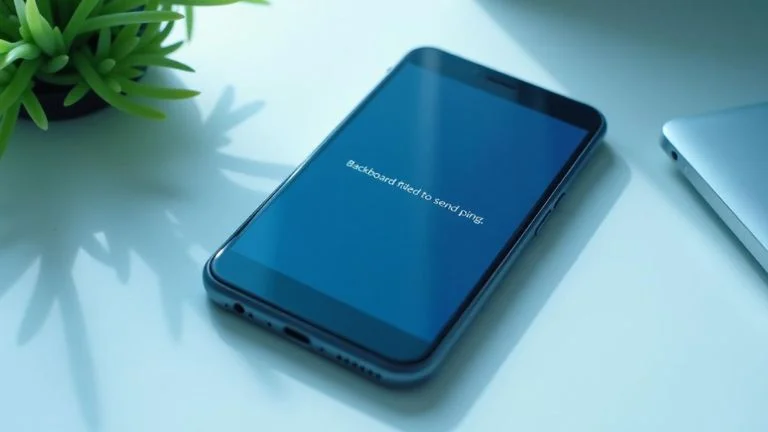Picture this: you’re scrolling through your iPhone, trying to get stuff done, and suddenly, a mysterious message pops up Backboard failed to send a ping. Sounds like something from a sci-fi movie, right? But no, it’s a standard error on iOS 14.6 that leaves many iPhone users scratching their heads.
If you’ve seen this message, you’re probably wondering what it means, why it’s happening, and, more importantly, how to fix it. Well, you’re in luck! In this blog post, I’ll explain it all in plain English. There is no confusing tech jargon or overwhelming details, just straightforward advice to help you fix the issue.
By the end of this guide, you’ll know what backboard failed to send ping means and how to troubleshoot it step-by-step; we’ll even compare what worked for others and what didn’t so you have the most detailed information available. Ready? Let’s dive in.
What Does Backboard Failed to Send Ping Mean?
Before we discuss solutions, let’s first understand what’s going on. Backboard isn’t some sports equipment here; it’s a background service in iOS that helps manage interactions between your phone’s interface and hardware, such as the touchscreen, gestures, and even how apps appear on the screen.
When you see failed to send a ping, something went wrong in this communication. The system tried to check the status of the device’s interface, but the ping (or signal) didn’t go through. It could be due to a software bug, outdated settings, or app conflicts.
So, now that we know what it means, let’s talk solutions!
Quick Fixes for the Backboard Failed to Send Ping Issue
1. Restart Your iPhone
I know this sounds super basic, but a simple restart can sometimes work wonders. Here’s how to do it:
- Press and hold the power button (or the side button on newer models) until the slider appears.
- Drag the slider to turn off your iPhone.
- Please wait a few seconds, then turn it back on.
This little trick often clears temporary glitches in the system, including the pesky backboard issue.
2. Force Restart Your iPhone
You can try a force restart if a normal restart doesn’t work. It’s like hitting the reset button on your phone but without losing any data:
- For iPhone 8 and newer: Quickly press and release the Volume Up button, then do the same with the Volume Down button. Finally, press and hold the side button until you see the Apple logo.
- For iPhone 7 and 7 Plus: Press and hold the Volume Down and Sleep/Wake buttons until you see the Apple logo.
- For iPhone 6s and earlier: Press and hold both the Home and Sleep/Wake buttons until you see the Apple logo.
Force restarting can resolve more stubborn issues by completely rebooting the iPhone’s systems.
iOS 14.6: Is It the Culprit?
It’s no secret that iOS updates can sometimes introduce more bugs than they fix. iOS 14.6, while packed with new features, has also caused users a few headaches, with the “Backboard failed to send ping” error being one of them.
Here are some reasons why iOS 14.6 might be causing this error:
- Increased Background Activity: Updates often lead to more background processes as apps adjust to the new system. You might see this error if the backboard fails to keep up with the additional load.
- App Incompatibilities: Some apps may need to be fully optimized for the latest iOS version, causing conflicts with core system services.
- Bugs in the Code: Let’s face it: no iOS update is perfect. Bugs slip through even the most rigorous testing.
Digging Deeper: Solutions that Work (and Why They’re Better)
3. Check for Software Updates
One of the best things you can do is ensure your iPhone is running the latest version of iOS. If Apple had already caught this issue, they might have patched it with a newer update. To check:
- Go to Settings > General > Software Update.
- If there’s an update available, install it and see if the problem persists.
New software patches often iron out minor bugs that are causing big problems.
4. Reset All Settings
Sometimes, settings from previous versions of iOS can mess with your system’s ability to function correctly. Resetting all settings might clear up any hidden conflicts without erasing your data:
- Go to Settings > General > Reset > Reset All Settings.
- This will reset system preferences like Wi-Fi passwords but won’t delete personal files or apps.
While it’s more involved, many users have reported success with this method when other steps failed.
Advanced Fixes for Persistent Issues
5. Reinstall the iOS Update Using Recovery Mode
If the above methods don’t work, you may need to reinstall iOS entirely. Recovery mode allows you to reinstall the software without deleting your data. Here’s how:
- Connect your iPhone to a computer (Mac or PC).
- Open Finder (Mac) or iTunes (PC).
- Enter recovery mode:
- For iPhone 8 or newer: Quickly press and release the Volume Up button, followed by the Volume Down button, then press and hold the Side button until the recovery mode screen appears.
- For iPhone 7: Press the Volume Down and Sleep/Wake buttons until the recovery mode screen appears.
- For iPhone 6s or earlier: Press and hold both the Home and Sleep/Wake buttons until the recovery mode screen appears.
- In iTunes or Finder, choose “Update” (not “Restore”) to reinstall iOS.
This method ensures you get a fresh version of iOS without wiping your data.
6. Contact Apple Support
If all else fails, it might be time to call in the experts. Apple Support can run diagnostic tests on your device to identify the root cause of the issue. Sometimes, hardware problems contribute to software errors.
Competitor Analysis: What’s Missing in Other Blog Posts
After scouring the web, I found that many blog posts addressing the “Backboard failed to send ping” error either lack depth or miss out on essential troubleshooting steps. Most posts fall into one of three categories:
- Overly Technical: Some blogs dive into the error codes, and developers speak without offering simple, actionable advice.
- Shallow Fixes: Others give the “restart your phone” tip but don’t provide more advanced solutions like reinstalling iOS or checking for app conflicts.
- Outdated Information: I found several articles suggesting obsolete methods that don’t apply to iOS 14.6 or newer versions, leading readers in the wrong direction.
Here’s what makes this post better:
- Comprehensive Steps: I’ve laid out both basic and advanced solutions, ensuring readers have various fixes to try.
- Easy-to-understand Language: I’ve avoided confusing tech jargon and kept the language simple so anyone can follow along.
- Updated Information: This post explicitly addresses the iOS 14.6 update, making it more relevant than older guides focusing on previous versions.
Preventing Future Errors: Tips to Keep Your iPhone Running Smoothly
Dealing with errors like this can be frustrating, but there are steps you can take to minimize the chances of running into them again:
- Keep Your iPhone Updated: Apple regularly releases updates that address bugs and improve system performance.
- Close Unused Apps: Too many open apps can slow down your device and increase the chance of background services (like Backboard) failing.
- Free Up Storage Space: Low storage on your iPhone can impact performance. Deleting unnecessary apps or files will ensure you have enough free space.
- Avoid Beta Versions: While iOS beta versions let you test new features, they often have bugs. Stick to stable releases unless you enjoy troubleshooting!
Conclusion:
The “Backboard failed to send ping” error may sound complicated, but with the proper steps, it’s entirely fixable. Whether you go for a quick restart or a more advanced solution like reinstalling iOS, the key is to stay patient and methodical.
If this post helped you, let me know in the comments! If you found another trick that worked, share it below; it could help someone battling the same problem. Thanks for reading, and good luck getting your iPhone back to peak performance!
May You Like Also: Best Practices for Optimizing Enterprise Search Functionality




